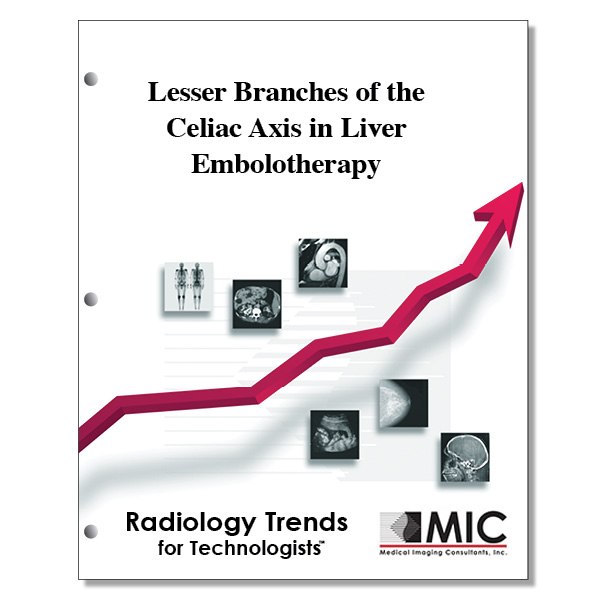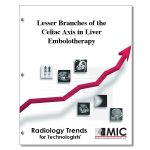

Lesser Branches of the Celiac Axis in Liver Embolotherapy
An overview of anatomic variants of the common hepatic artery, parasitized collateral vessels of the celiac axis that may supply liver tumors, and non-hepatic branches of the hepatic circulation.
Course ID: Q00350 Category: Radiology Trends for Technologists Modalities: Nuclear Medicine, Vascular Interventional2.75 |
Satisfaction Guarantee |
$29.00
- Targeted CE
- Outline
- Objectives
Targeted CE per ARRT’s Discipline, Category, and Subcategory classification:
[Note: Discipline-specific Targeted CE credits may be less than the total Category A credits approved for this course.]
Computed Tomography: 2.00
Procedures: 2.00
Abdomen and Pelvis: 2.00
Magnetic Resonance Imaging: 2.00
Procedures: 2.00
Body: 2.00
Nuclear Medicine Technology: 1.50
Procedures: 1.50
Gastrointestinal and Genitourinary Procedures: 1.50
Registered Radiologist Assistant: 2.75
Procedures: 2.75
Neurological, Vascular, and Lymphatic Sections: 2.75
Sonography: 2.00
Procedures: 2.00
Abdomen: 2.00
Radiation Therapy: 2.00
Procedures: 2.00
Treatment Sites and Tumors: 2.00
Vascular-Interventional Radiography: 2.75
Procedures: 2.75
Vascular Interventional Procedures: 2.75
Vascular Sonography: 2.00
Procedures: 2.00
Abdominal/Pelvic Vasculature: 2.00
Outline
- Introduction
- Classic Hepatic Arterial Anatomic Variants
- Replaced or Accessory LHA
- Replaced or Accessory RHA
- Other Anatomic Variants
- Parasitized Collateral Vessels of the Celiac Axis Involved in Tumor Supply
- Right Inferior Phrenic Artery
- Omental Arteries
- Cystic Artery
- Nonhepatic Branches of the Hepatic Arterial Circulation to Cinsider in Vascular Optimization for Liver Embolotherapy
- CHA Territory
- PHA Territory
- LHA Territory
- RHA Territory
- Conclusions
Objectives
Upon completion of this course, students will:
- know the curative treatment options for hepatic malignancy
- understand the challenges liver transplant patients face
- understand the therapeutic options for nonsurgical cases of hepatic malignancy
- know the percentage of hepatic tumors obtaining their blood supply from the hepatic arteries
- discuss the percentage of patients with conventional hepatic anatomy including origin of the RHA and LHA in these patients
- understand targeted arteries during embolization therapy and the primary goal of vascular optimization
- define aberrant
- note the two types of aberrant hepatic arteries
- understand the segmentation system of the liver and its advantages
- know the classical origination of the left hepatic artery
- define anomalous and the importance of the term
- note the percentage of the population that has a replaced right hepatic artery
- know what segment of the liver is fed by the left hepatic artery
- know what percentage of the population has a replaced common hepatic artery
- discuss the percentage and size of tumors demonstrating collateral blood supply
- define TACE
- know the most commonly identified extrahepatic collateral vessel during TACE
- identify what area of the body receives blood from the phrenic arteries
- describe the side effects of right inferior phrenic artery chemoembolization
- describe the omentum
- be familiar with the origin of the gastroepiploic arteries
- list the three areas of the body supplied by the cystic artery
- describe a side effect from chemoembolization of the cystic artery
- know the primary goal of vascular optimization prior to radioembolization
- understand the most frequently targeted arteries to receive prophylactic embolization
- know what area of the body is supplied by the gastroduodenal artery
- note the most common origination point for the dorsal pancreatic artery
- list the arteries located in the proper hepatic artery territory
- understand why the right gastric artery is difficult to catheterize
- discuss how the supraduodenal artery can be identified
- know when is it necessary to coil the retroduodenal artery
- know what area of the body the left gastric artery supplies
- list the two arteries from which the falciform artery can originate
- know where the cystic artery originates
- describe how the cystic artery appears on angiographic images
